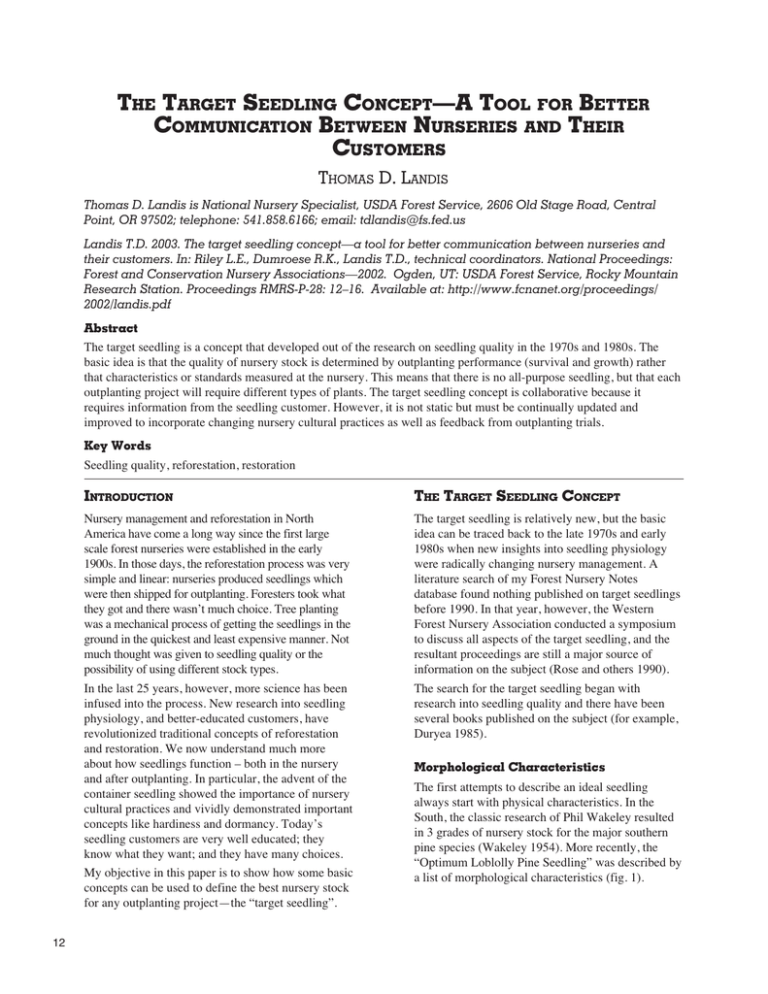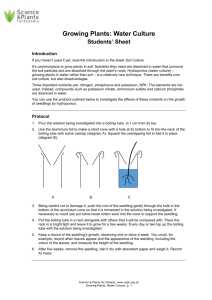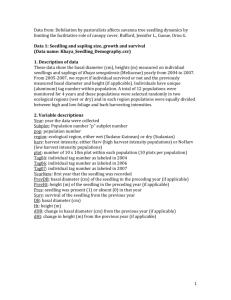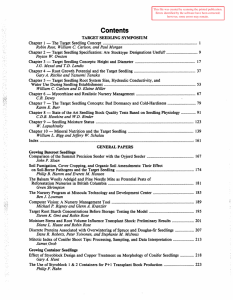T S C —A T
advertisement

THE TARGET SEEDLING CONCEPT—A TOOL FOR BETTER COMMUNICATION BETWEEN NURSERIES AND THEIR CUSTOMERS THOMAS D. LANDIS Thomas D. Landis is National Nursery Specialist, USDA Forest Service, 2606 Old Stage Road, Central Point, OR 97502; telephone: 541.858.6166; email: tdlandis@fs.fed.us Landis T.D. 2003. The target seedling concept—a tool for better communication between nurseries and their customers. In: Riley L.E., Dumroese R.K., Landis T.D., technical coordinators. National Proceedings: Forest and Conservation Nursery Associations—2002. Ogden, UT: USDA Forest Service, Rocky Mountain Research Station. Proceedings RMRS-P-28: 12–16. Available at: http://www.fcnanet.org/proceedings/ 2002/landis.pdf Abstract The target seedling is a concept that developed out of the research on seedling quality in the 1970s and 1980s. The basic idea is that the quality of nursery stock is determined by outplanting performance (survival and growth) rather that characteristics or standards measured at the nursery. This means that there is no all-purpose seedling, but that each outplanting project will require different types of plants. The target seedling concept is collaborative because it requires information from the seedling customer. However, it is not static but must be continually updated and improved to incorporate changing nursery cultural practices as well as feedback from outplanting trials. Key Words Seedling quality, reforestation, restoration 12 INTRODUCTION THE TARGET SEEDLING CONCEPT Nursery management and reforestation in North America have come a long way since the first large scale forest nurseries were established in the early 1900s. In those days, the reforestation process was very simple and linear: nurseries produced seedlings which were then shipped for outplanting. Foresters took what they got and there wasn’t much choice. Tree planting was a mechanical process of getting the seedlings in the ground in the quickest and least expensive manner. Not much thought was given to seedling quality or the possibility of using different stock types. In the last 25 years, however, more science has been infused into the process. New research into seedling physiology, and better-educated customers, have revolutionized traditional concepts of reforestation and restoration. We now understand much more about how seedlings function – both in the nursery and after outplanting. In particular, the advent of the container seedling showed the importance of nursery cultural practices and vividly demonstrated important concepts like hardiness and dormancy. Today’s seedling customers are very well educated; they know what they want; and they have many choices. My objective in this paper is to show how some basic concepts can be used to define the best nursery stock for any outplanting project—the “target seedling”. The target seedling is relatively new, but the basic idea can be traced back to the late 1970s and early 1980s when new insights into seedling physiology were radically changing nursery management. A literature search of my Forest Nursery Notes database found nothing published on target seedlings before 1990. In that year, however, the Western Forest Nursery Association conducted a symposium to discuss all aspects of the target seedling, and the resultant proceedings are still a major source of information on the subject (Rose and others 1990). The search for the target seedling began with research into seedling quality and there have been several books published on the subject (for example, Duryea 1985). Morphological Characteristics The first attempts to describe an ideal seedling always start with physical characteristics. In the South, the classic research of Phil Wakeley resulted in 3 grades of nursery stock for the major southern pine species (Wakeley 1954). More recently, the “Optimum Loblolly Pine Seedling” was described by a list of morphological characteristics (fig. 1). seedling stock types would do best on that particular site (fig. 2). These aspects of seedling quality are important but there are other considerations when trying to define a target seedling. DEFINING THE TARGET SEEDLING A target seedling is a plant that has been cultured to survive and grow on a specific outplanting site, and can be defined in 6 sequential steps (fig. 3). Figure 1. Although morphological characteristics can be used to grade seedlings, they do not give a full picture of the target seedling. Physiological Characteristics Wakeley’s studies on the ideal pine seedling convinced him that there were physiological aspects of seedling quality that were just as important as morphological characteristics (Wakeley 1954). In recent years, most of the research on seedling quality has focused on physiological attributes such as dormancy and hardiness. Figure 2. Reforestation prescriptions reflect the concept that seedling quality must be determined on the outplanting site (modified from BC Ministry of Forests 1998). Outplanting Performance Even if we can precisely describe the morphological and physiological aspects of a seedling, that does not allow prediction of outplanting performance. One of the basic tenets of the target seedling concept is that seedling quality is determined by survival and growth on the outplanting site. Seedling quality depends on the how the seedlings will be used, or “fitness for purpose” (Ritchie 1984). This means that seedling quality cannot be merely described at the nursery; it can only be proven on the outplanting site. There is no such thing as an “all-purpose” tree seedling. A nice looking seedling at the nursery will not survive and grow well on all sites. In recent years, foresters have begun to develop site prescriptions for reforestation which describe which Figure 3. The 6 components of the target seedling concept. 13 1. Objectives of the Outplanting Project The reason why seedlings are being planted will have a critical influence on the characteristics of the target seedling. In traditional reforestation, commercially valuable tree species that have been genetically improved for fast growth are outplanted with the ultimate objective of producing saw logs or pulp. The target seedling for a restoration project will be radically different. A watershed protection project would require riparian trees and shrubs and wetland plants that will not be harvested for any commercial product. Conservation planting projects can have still different objectives. For example, to establish windbreaks in low rainfall areas with no native trees, exotic species may be required. Fire restoration projects will have different objectives depending on the plant community type and the ultimate use of the land. Project objectives for a burned rangeland might be to stop soil erosion, replace exotic weed species with natives, and establish browse plants for deer or elk. Target plant materials for this project might include a direct seeding of native grass and forbs, followed by an outplanting of woody shrub nursery stock. For a burned commercial forest, however, the plant materials would be native grass seed to stop erosion and then outplanting of tree seedlings to bring the land back to full productivity as soon as possible. container transplant. This stock type (technically a plug+1⁄2) is produced by growing a small volume container seedling early in the season and then transplanting them in the spring to a bareroot bed where they grow for the rest of the year. Rooted Cuttings—In addition to the traditional seedling stock types, nurseries also produce plants by vegetative propagation. Some plants, notably willows and cottonwoods, are most easily propagated by rooting cuttings. Demand for willow and cottonwood species has become more common in the last decade because of an increased interest in riparian restoration. There are drawbacks to vegetative propagation, however. Sexual propagation results in a mixture of genetic characteristics so that the offspring contain both male and female plants. On the other hand, asexual propagation methods produce exact clones of the mother plant. This is of particular concern with dioecious plants, such as Salix and Populus, because all the progeny produced by vegetative propagation will have the same sex as their parent (fig. 4). 2. Type of Plant Materials The term “target seedling” is limited and should be expanded to include all types of plant materials that are available from nurseries: seeds, seedlings, and rooted cuttings. Seeds—Although direct seeding is rarely used in reforestation, seeds of native grasses, forbs, and shrubs are widely used in restoration. Federal and state nurseries have been leaders in this field. For example, the JH Stone Nursery in southern Oregon is currently producing over 30 species of native grasses and forbs. Grass seed of commercial cultivars has been used in restoration projects for decades; but it has just been in the past 10 years that reliable supplies of locally produced, source-identified seeds have been available. Seedlings—Nurseries are currently producing a wide variety of seedling stock types. In the southern states, the 1+0 seedling is most common. But in the Pacific Northwest, nurseries grow mostly 2+0 seedlings plus 1+1 and plug+1 transplants. New stock types are continually being developed, such as the one-year 14 Figure 4. The target seedling concept must consider whether plants were propagated by seed or by cuttings, because the choice will affect both genetic and sexual diversity. 3. Source-identified Seeds or Cuttings The next component in the target seedling concept is concerned with adaptation; all nursery managers and reforestation specialists are familiar with the idea of seed source. They know that plant species vary throughout their geographic range because they are adapted to local site conditions. Using a local seed source and collecting from enough individuals to maintain genetic diversity are basic tenets of restoration ecology. The same principles apply to plants that must be propagated vegetatively. Cuttings must be collected from near the outplanting site to make sure that they are properly adapted. Proper seed source can be guaranteed through the use of seed zones, and so the location and elevation of seed are always recorded and included in the seed source identification code. 4. Limiting Factors on the Outplanting Site The fourth aspect of the target seedling concept concerns the ecological “principle of limiting factors”. The specifications of the target seedling should be developed by identifying which environmental factors will be most limiting to survival and growth on that particular site. For example, a fire restoration site in New Mexico might have shallow soils and competition for moisture and nutrients from grasses. On the Kenai peninsula in Alaska, however, cold soil temperatures are the limiting factor. Temperature measurements in the shallow rooting zone do not exceed 50 °F (10 °C) during the summer and research has shown that root growth almost stops completely below this temperature threshold (fig. 5). After the seedling customer supplies information about their particular outplanting site, the nursery manager can produce a seedling with the best chances to survive and grow. One outplanting site condition deserves special mention: mycorrhizal fungi. Reforestation sites typically have an adequate complement of mycorrhizal fungi that quickly infect outplanted seedlings whereas many restoration sites do not. For example, severe forest fires or mining operations eliminate all soil microorganisms including mycorrhizal fungi. Therefore, seedlings destined for these sites should receive inoculation with the appropriate fungal symbiont before outplanting. The timing of the inoculation must also be considered because many mycorrhizal fungi will not survive in the high nutrient environment of the nursery. Figure 5. At high latitudes and elevations, cold soil temperatures are often more limiting than soil moisture. 5. Timing of the Outplanting Window The timing of the outplanting project is the fifth aspect of the target seedling concept that must be considered. The outplanting window is the period of time in which environmental conditions on the outplanting site are most favorable for survival and growth. As mentioned in the previous section, soil moisture and temperature are the usual constraints. In the Pacific Northwest, seedlings are outplanted during the rains of winter or early spring but, because winters in Mexico are sunny and dry, seedling outplanting is done early in the summer rainy season. Soil temperature rather than moisture is the consideration at high elevations or latitudes. In Alaska, the outplanting window is later in the summer when soil temperatures are at their peak. 15 Using this information from the seedling customer, a growing schedule for the target seedling can be constructed. Starting at the date of delivery, the nursery manager plans backwards to determine how much time will be required to produce a seedling with the target specifications. 6. Type of Outplanting Tool The last aspect of the target seedling concept is how the seedlings are going to be outplanted. There is an ideal planting tool for each outplanting site. All too often, foresters or other seedling customers will develop a preference for a particular implement because it has worked well in the past. However, no one tool will work under all site conditions. Special planting hoes called hoedads are popular in the steep terrain of the Pacific Northwest, but shovels or planting bars are traditionally used in Mexico. The level terrain in the Southern Coastal Plain or on the Kenai peninsula in Alaska allows machine planting. Nursery managers must know the planting tools in advance so that they can grow target seedlings with the appropriate root length and volume. IMPROVING THE TARGET SEEDLING The target seedling is not a static concept but must be continually updated and improved. At the start of the project, the forester and the nursery manager must agree on certain seedling specifications. This prototype target seedling must be verified by outplanting trials in which survival and growth are monitored for up to 5 years (fig. 6). The first few months are critical, because seedlings that die immediately after outplanting indicate a problem with stock quality. Plants that survive initially but gradually lose vigor indicate poor planting or drought conditions. Therefore, plots must be monitored during and at the end of the first year for initial survival. Subsequent checks after 3 or 5 years will give a good indication of seedling growth potential. This performance information is then used to give valuable feedback to the nursery manager who can fine tune the target seedling specifications for the next crop (fig. 6). SUMMARY The target seedling concept emphasizes that seedling quality cannot be defined in the nursery but instead must be proven on the outplanting site. Successful reforestation and restoration projects require good communications between the seedling user and the nursery manager. Instead of the traditional linear 16 Figure 6. The target seedling must be continually updated with information from outplanting trials. process which begins in the nursery, the target seedling concept is viewed as a circular feedback system where information from the outplanting site is used to define and refine the best type of seedling. REFERENCES BC Ministry of Forests. 1998. Provincial seedling stock type selection and ordering guidelines. Victoria (BC): Ministry of Forests, Forestry Division. 71 p. Duryea ML, editor. 1985. Evaluating seedling quality: principles, procedures, and predictive abilities of major tests. Corvallis (OR): Forest Research Laboratory, Oregon State University. 143 p. Ritchie GA. 1984. Assessing seedling quality. In: Duryea ML, Landis TD, editors. Forest nursery manual: production of bareroot seedlings. The Hague/Boston/Lancaster: Martinus Nijhoff/Dr W Junk Publishers for Forest Research Laboratory, Oregon State University, Corvallis. p 243-259. Rose R, Campbell SJ, Landis TD. 1990. Target seedling symposium: proceedings, combined meeting of the western forest nursery associations; 1990 August 13-17; Roseburg, OR. Fort Collins (CO): USDA Forest Service, Rocky Mountain Forest and Range Experiment Station. General Technical Report RM-200. 286 p. Wakeley PC. 1954. Planting the southern pines. Washington (DC): USDA Forest Service Agricultural Monograph No.18. 233 p.






